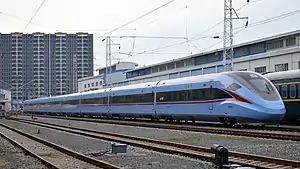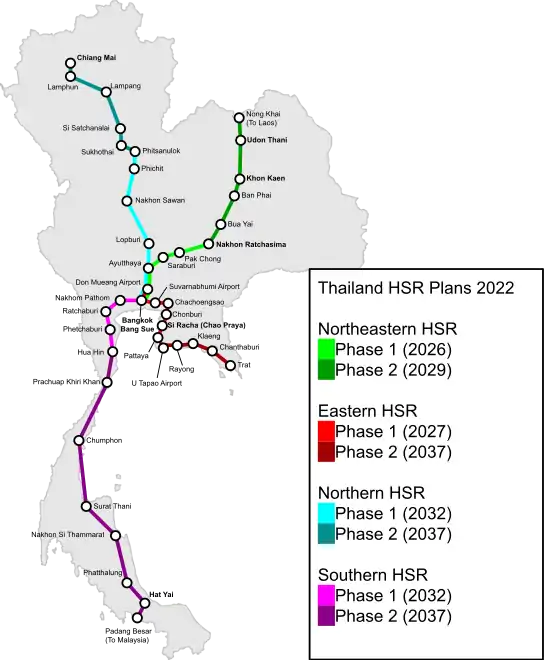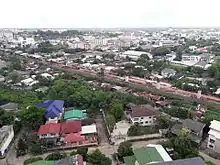High-speed rail in Thailand
Although Thailand has no operational high-speed rail lines, the country has a plan for a large high speed rail network connecting its major cities. The first line of the network is under construction from Bangkok to Nakhon Ratchasima, with a planned maximum operational speed of 250 km/h (155 mph).
| Thailand high-speed rail | |
|---|---|
 | |
| Overview | |
| Status | Varies by segment |
| Locale | Thailand |
| Service | |
| Type | High-speed rail |
| Operator(s) | State Railway of Thailand |
| Technical | |
| Track gauge | 1,435 mm (4 ft 8+1⁄2 in) standard gauge |
| Operating speed | 300 km/h (186 mph) (Design) 250 km/h (155 mph) (Operational) |
History
In October 2010, the Thai Parliament approved initial proposals for a high-speed rail (HSR) network. Five lines capable of handling 250 km/h (155 mph) speeds would radiate from Bangkok.[1]
In March 2013, the transport minister revealed that only one company would be selected to run all high-speed train routes, scheduled to be operational between 2018 and 2019.[2] The first 86 km (53 mi) section from Krung Thep Aphiwat to Ayuthaya was planned to be tendered in late-2013. However, a seven-month political crisis involving the dissolution of parliament and an annulled February 2014 election culminated in a military coup in May 2014. In July 2014 the new military junta deferred all HSR plans until a civilian government is installed.
Following the military coup of May 2014 and his elevation to the office of prime minister, Gen Prayut Chan-o-cha proposed connecting Bangkok to two popular resort cities, Pattaya and Hua Hin, by high-speed rail. The Transport Ministry's Office of Transport and Traffic Policy and Planning had earlier conducted studies on both routes. They assumed that, for the Bangkok-Pattaya line, trains would run through Chachoengsao, Chonburi, and Pattaya, terminating in Rayong, a distance of 194 km (121 mi). Construction costs were estimated at 152 billion baht with an economic internal rate of return (EIRR) of 13%. Construction would take about 54 months. The route to Hua Hin would be 209 km (130 mi) in length with an investment cost of about 98 billion baht and EIRR of 8.1%. The office concluded that these routes would be of little interest to private investors due to the high investment required coupled with a low rate of return.[3] Four HSR lines were included in fiscal year 2017 plans.[4]
Proposed high-speed routes

| No. | High-Speed Corridor | Route | Operation Speed | Length | Funding Model | Cost | Projected Operation | Status |
|---|---|---|---|---|---|---|---|---|
| 1 | Northeastern HSR Phase 1 | Krung Thep Aphiwat–Don Mueang–Ayutthaya–Saraburi–Pak Chong–Nakhon Ratchasima | 160–250 km/h (99–155 mph) | 250.8 km (155.8 mi)[5] | PPP Net Cost[6][7] | 179,412.21 million baht[5][8][9] (5,986 million USD) | "could be in service by 2026"[10] | Under construction |
| 2 | Eastern HSR Phase 1 | Don Mueang–Krung Thep Aphiwat–Makkasan–Suvarnabhumi Airport–Chachoengsao–Chonburi–Si Racha–Pattaya–U-Tapao | 250 km/h (160 mph) | 220 km (140 mi) | PPP Net Cost | 224,544 million baht (7,492 million USD)[11] | 2029 | Site preparation |
| 3 | Northeastern HSR Phase 2 | Nakhon Ratchasima–Bua Yai–Ban Phai–Khon Kaen–Udon Thani–Nong Khai | 250 km/h (160 mph) | 356.01 km (221.21 mi) | PPP Net Cost[6][7] | 226,340 million baht (7,552 million USD) | 2029 | Planning stage. The 2nd phase is "scheduled (as of Q2 2023) to begin [construction] in 2024".[12] |
| 4 | Eastern HSR Phase 2 | U-Tapao–Rayong–Klaeng–Chanthaburi–Trat[13] | 250 km/h (160 mph) | 190 km (120 mi) | PPP Net Cost | 159,111 million baht (5,309 million USD) | 2037[14] | Planning stage |
| 5 | Northern HSR Phase 1 | Krung Thep Aphiwat–Don Mueang–Ayutthaya–Lopburi–Nakhon Sawan–Phichit–Phitsanulok | 300 km/h (190 mph) | 380 km (240 mi) | Japan | 212,892 million baht (7,103 million USD) | 2032 | Planning stage |
| 6 | Southern HSR Phase 1 | Krung Thep Aphiwat–Nakhon Pathom–Ratchaburi–Phetchaburi–Hua Hin | 300 km/h (190 mph) | 211 km (131 mi) | PPP Net Cost | 100,125 million baht (3,341 million USD) | 2032 | Planning stage |
| 7 | Northern HSR Phase 2 | Phitsanulok–Sukhothai–Si Satchanalai–Lampang–Lamphun–Chiang Mai | 300 km/h (190 mph) | 288 km (179 mi) | Japan | 232,411 million baht (7,755 million USD) | 2037 | Planning stage |
| 8 | Southern HSR Phase 2 | Hua Hin–Prachuap Khiri Khan–Chumphon–Surat Thani–Nakhon Si Thammarat–Phatthalung–Hat Yai–Padang Besar | 300 km/h (190 mph) | 759 km (472 mi) | PPP Net Cost | 432,329 million baht (14,425 million USD) | 2037 | Planning stage |
Northeastern HSR: Bangkok–Nakhon Ratchasima–Nong Khai (Sino-Thai railway project)

In November 2014, Thailand and China signed a memorandum of understanding agreeing to construct the Thai portion of the transnational railway running from Kunming, China to the Gulf of Thailand. In November 2015, both parties agreed to a division of labour. Under the framework, a joint venture would be set up to run the project. China would conduct feasibility studies, design the system, construct tunnels and bridges, and lay track. The MoU stipulates that Thailand is responsible for 100% investment in the project and operates the construction itself, including conducting social and environmental impact studies, expropriating land for construction, handling general civil engineering and power supply, and supplying construction materials.[7]
Once built, China will operate and maintain the system for the first three years of operation. Between the third and the seventh years, both countries would share responsibility. Later Thailand would take on responsibility with China as adviser. China would train Thai personnel to operate and maintain the system.
Dual standard-gauge tracks would be laid throughout the project. In Thailand, two routes would diverge at a junction in Kaeng Khoi District in Saraburi Province. One to connect Bangkok to Kaeng Khoi. The other route to connect Kaeng Khoi with Map Ta Phut of Rayong Province. From Kaeng Khoi tracks would lead north to Nakhon Ratchasima and on to Nong Khai Province. Construction would be divided into four sections: Bangkok-Kaeng Khoi, Map Ta Phut-Kaeng Khoi, Kaeng Khoi-Nakhon Ratchasima, Nakhon Ratchasima-Nong Khai.
Construction of Thailand's 873-kilometre-long portion of the railway system started in December 2017[15][16] The railway will connect to the 417 km Boten–Vientiane railway and a 520 km line from the Lao border to Kunming.[17] In July 2021, authorities said: "works which will have to be postponed are the [... tracks] between Nawa Nakhon and Ban Pho, between Phra Kaeo and Saraburi"; furthermore another postponement, "presumably until [... 2022 is] the section between Don Muang and Nawa Nakhon".[18] As of Q4 2022, the "first phase between Bangkok and Nakhon Ratchasima is [...] behind schedule"; furthermore, it's "15% completed when it should have been 37%"; the Phase 1 line was[19][10] due to be completed in 2026 - however, media says that the main contract will have to be extended, according to a source at the Transport Ministry.
Eastern HSR: Bangkok–U-Tapao Airport
A HSR line to the eastern seaboard was first proposed in 1996 but there was no progress for over a decade. In 2009, the government requested the Office of Transport and Traffic Policy and Planning (OTP) to create a plan for new HSR network in Thailand that included an eastern HSR line to Rayong. The route was finalised before the 2011 election with the promise to begin construction the next year if the government was re-elected, but they lost the election. After the 2011 election, the new government reviewed all HSR plans and the SRT stated that the line would be tendered in early-2014.[20] After the May 2014 coup there were further delays while the military government reviewed all HSR lines, initially deferring all projects. In early-2016, the government agreed to proceed with the eastern HSR route and suggested that it could be extended to Don Mueang International Airport beyond the terminus at Krung Thep Aphiwat Central Terminal thus providing a link with three airports.[21] Extending the line would provide a link between Don Mueang Airport, Suvarnabhumi Airport, and U-Tapao International Airport in Ban Chang District.
During 2017, OTP and the Ministry of Transport in consultation with the SRT agreed that by extending the line to terminate at Don Mueang it would effectively include the long delayed extension of the Airport Rail Link (Bangkok) from Makkasan Station to Don Mueang Airport as part of the project. The Eastern Economic Corridor Office (EEC Office) in October 2017 finalised previous OTP plans to build the 10 station Eastern HSR line linking Don Mueang airport, Krung Thep Aphiwat, Makkasan, Suvarnabhumi Airport, Chonburi, Si Racha, Pattaya, U-Tapao Airport, and Rayong. In early-2018, the section to Rayong was excluded due to environmental and safety concerns and it was decided that the line would terminate at U-Tapao Airport.[22]
The SRT stated that the first tenders for the Eastern HSR line are expected to be tendered by May 2018 with a four-month auction period before the contract is awarded.[23] The cost of the project was estimated to be over 200 billion baht, of which the Thai Government would fund 123 billion baht and the private sector estimated to contribute 90 billion baht.[24][25]
Two rival consortia vied for the airport link contract.[26] The Charoen Pokphand (CP) Group-led consortium consisting of Italian-Thai Development, China Railway Construction Corporation Ltd, CH. Karnchang, and Bangkok Expressway and Metro, won the project with a 224 billion baht bid in December 2018. Their winning bid is valid until 8 November 2019. Until 16 October 2019, the consortium had refused to sign the contract, citing land expropriation and eviction problems and the consortium's request that the government share the risk in the project.[27] Negotiations were further complicated by the resignation of the entire board of the State Railway.[28] On 16 October 2019, news reports announced that the CP consortium intends to sign the rail deal on 25 October.[29] Tanit Sorat, vice-chairman of the Employers' Confederation of Thai Trade and Industry, said that the contract signing delays are, "...unlikely to affect the project because the government will carry out the project smoothly."[27] The project was eventually approved in October 2019 as a public private partnership between the Thai government and Charoen Pokphand/China Railway Construction Corporation. The assets will revert to state ownership after 50 years.[30] It is scheduled to start construction in 2023 and open for service in 2029.[31]
Northern HSR: Bangkok–Phitsanulok–Chiang Mai (Japanese-Thai project)
Japan would provide Shinkansen technology for a high-speed rail link between Bangkok and the northern city of Chiang Mai. Phase 1 would connect Bangkok to Phitsanulok. It is estimated to cost 280 billion baht. Seven stations are planned for this segment: Krung Thep Aphiwat, Don Mueang, Ayutthaya, Lopburi, Nakhon Sawan, Phichit, and Phitsanulok. To reduce costs, Thai authorities have proposed reducing the number of stations, but the Japan International Cooperation Agency (JICA) has rejected this suggestion on the grounds that it defeats the original purpose of the project.[32] This portion of the route was scheduled to be submitted to the Thai cabinet for financial approval in August 2018.[32]
After an initial cooperation agreement was signed in 2015, the Thai government formally requested the technical and financial assistance of the Japanese government in late-2016 for the building of the Northern HSR line to Chiang Mai.[33] The Japanese completed a feasibility study which estimated that the project will cost 420 billion baht to build.[34]
A feasibility study by JICA in mid-2018 reported that the train as planned would run at a loss. JICA's study projects only 10,000 passengers per day on the route, as opposed to the 30,000 per day forecasted in the original planning proposals. To be profitable from ticket sales would require 50,000 fares per day.[32]
The Thai government announced in September 2019 that it may cancel Bangkok-Chiang Mai high-speed rail project after private investors declined to invest. The cost of the 670 kilometre line is estimated to be 400 billion baht. Japan has turned down the project as a bad investment due to low passenger projections.[35] However Ministry of Transport denies that Japan cancelled the project.[36]
On 14 December 2022, the Department of Railways is discussing with MLIT-JICA to speed up the conclusion of economic and financial feasibility studies for the high-speed rail between Bangkok and Chiang Mai, to be completed in March 2023. Additionally, the Department has asked for a study of the economic return from the development of the area around the station.[37] On March 8, 2023, the economic and financial feasibility study for the high-speed rail project from Bangkok to Chiang Mai, Phase 1 from Bangkok to Phitsanulok, was completed. The study included an analysis of direct and indirect benefits and found that the project is worth the investment. The economic return (EIRR) is 17.3 percent, which is 12 percent higher than the threshold, and the net present value (NPV) is positive over the period of operation.[38]
References
- "Thailand to negotiate with China on high-speed proposal". International Railway Journal. 30 October 2010. Archived from the original on 1 November 2010. Retrieved 30 October 2010.
- "Transport Minister: One firm will run all high-speed train routes". Thai Financial Post. 21 March 2013. Archived from the original on 2 February 2014.
- "Difficulty in implementing high-speed train to resort provinces". Mass Communication Organization of Thailand (MCOT). 14 February 2015. Archived from the original on 15 February 2015. Retrieved 15 February 2015.
- "4 high speed rail projects in FY 2017 investment plan". The Nation. 1 November 2016. Archived from the original on 24 March 2018.
- "Hi-speed rail work delayed over curbs". Bangkok Post. 27 July 2021. Retrieved 27 July 2021.
- รถไฟความเร็วสูง ไทย-จีน-ญี่ปุ่น (in Thai), retrieved 13 March 2023
- เปิดความแตกต่างโครงการรถไฟความเร็วสูงไทย - จีน VS โครงการรถไฟลาว - จีน, retrieved 13 March 2023
- Mokkhasen, Sasiwan (21 June 2017). "Did Thailand get railroaded by the Chinese? No way, govt says". Khaosod English. Thailand. Archived from the original on 20 November 2021. Retrieved 20 November 2021.
- "Thailand's high-speed railway will carry first passengers in 2023". Phuket Gazette. 4 September 2019. Archived from the original on 3 July 2021. Retrieved 7 September 2019.
- Marukatat, Saritdet (17 September 2021). "Nong Khai plans for rail link with China". Bangkok Post. Retrieved 17 September 2021.
- Signing Ceremony Program of Public Private Partnership (PPP) Agreement. The High-Speed Rail Linking Three Airports Project, retrieved 20 July 2020
- https://www.bangkokpost.com/thailand/general/2556205/china-envoy-lauds-belt-road-push. Bangkok Post. Retrieved 2023-04-25
- The High-speed Rail Linking Three Airports Project, Phase 2 (Extension Line: Rayong - Chanthaburi - Trat Section) (PDF), retrieved 8 July 2020
- HSR Market Sounding (PDF), 24 July 2020, retrieved 24 July 2020
- Wang, Brian (25 December 2017). "Thailand high speed rail construction starts". Next Big Future. Retrieved 29 December 2017.
- "Construction of Thai-Chinese railway begins". Bangkok Post. 21 December 2017. Archived from the original on 13 October 2021. Retrieved 29 December 2017.
- Jikkham, Patsara (17 November 2015). "Sino-Thai railway responsibilities set". Bangkok Post. Archived from the original on 13 October 2021. Retrieved 18 November 2015.
- "Hi-speed rail work delayed over curbs". Bangkok Post. 27 July 2021. Archived from the original on 13 October 2021. Retrieved 27 July 2021.
- https://www.bangkokpost.com/thailand/general/2432925/high-speed-rail-project-behind-schedule. Bangkok Post. Retrieved 2022-11-08
- Marukatat, Saritdet (13 May 2013). "Rayong added to high-speed rail link". Bangkok Post. Archived from the original on 13 October 2021.
- Mahitthirook, Amornrat (25 January 2016). "Military government set to link 3 airports". Bangkok Post. Archived from the original on 13 October 2021. Retrieved 12 October 2021.
- Theparat, Chatrudee; Chantanusornsiri, Wichit (14 February 2018). "EEC high-speed railway to steer clear of Rayong on safety fears". Bangkok Post. Archived from the original on 13 October 2021.
- Jotikasthira, Om (28 February 2018). "Auction for train contracts in April". Bangkok Post. Archived from the original on 13 October 2021.
- Theparat, Chatrudee; Jotikasthira, Om (9 March 2018). "New govt 'won't halt airport fast rail plan'". Bangkok Post. Archived from the original on 13 October 2021.
- Apisitniran, Lamonphet (20 March 2018). "Pitch set for airport rail link". Bangkok Post. Retrieved 21 March 2018.
- "CP, BTS groups set to bid for airport link high-speed railway". The Nation. 11 November 2018. Archived from the original on 12 November 2018. Retrieved 12 November 2018.
- Apisitiran, Lamonphet; Theparat, Chatrudee (14 October 2019). "Holding up the train". Bangkok Post. Archived from the original on 13 October 2021. Retrieved 16 October 2019.
- "SRT board members in mass resignation". The Nation. 30 September 2019. Archived from the original on 25 September 2020. Retrieved 16 October 2019.
- Leesa-Nguansuk, Suchit; Hongtong, Thodsapol (16 October 2019). "CP set to ink airport link deal". Bangkok Post. Archived from the original on 13 October 2021. Retrieved 16 October 2019.
- "Thailand gives green light for US$7.4 billion high-speed rail link between Bangkok and Pattaya". South China Morning Post. Reuters. 24 October 2019. Archived from the original on 13 October 2021. Retrieved 25 October 2019.
- รถไฟความเร็วสูงเชื่อม 3 สนามบินสร้างหรือยัง (in Thai), 3 March 2023
- Hongtong, Thodsapol (25 July 2018). "Losses predicted for high-speed railway". Bangkok Post. Archived from the original on 13 October 2021. Retrieved 25 July 2018.
- Mahitthirook, Amornrat (5 December 2016). "Government to ask Japan for rail project support". Bangkok Post. Archived from the original on 13 October 2021.
- Hongtong, Thodsapol (16 December 2017). "Bullet train project set to cost B420bn". Bangkok Post. Archived from the original on 13 October 2021.
- Hongtong, Thodsapol (27 September 2019). "Govt mulls end of fast train plan". Bangkok Post. Archived from the original on 13 October 2021. Retrieved 27 September 2019.
- "ก.คมนาคม ยันญี่ปุ่นไม่ยกเลิกลงทุนรถไฟความเร็วสูง". thaipbs.or.th (in Thai). 27 October 2018.
- ""กรมราง" ถก "ญี่ปุ่น" เร่งศึกษาลงทุนรถไฟความเร็วสูง "กรุงเทพฯ-เชียงใหม่" จบใน มี.ค. 66". 14 December 2022.
- เปิดเส้นทาง 'ไฮสปีดเทรน' ภาคเหนือ ลุ้นรัฐบาลใหม่เคาะตอกเสาเข็ม (in Thai), 11 March 2023
- "Hua Hin High-speed Rail Put on Fast Track". Hua Hin Today. 31 August 2016. Archived from the original on 8 August 2020. Retrieved 6 September 2019.
- "Muhyiddin floats idea of KL-Bangkok high-speed rail in Parliament". Coconuts KL. 30 September 2021.
.svg.png.webp)
